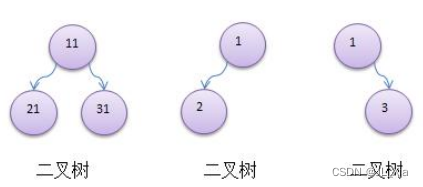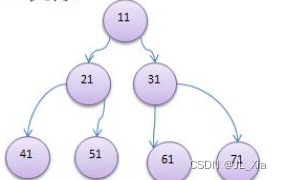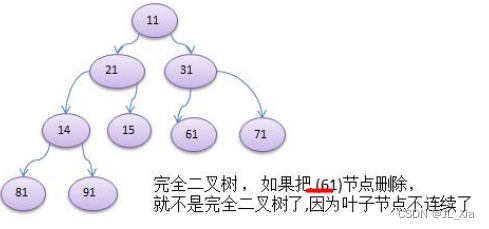1 二叉树的基本概念
(1)树有很多种,每个节点最多只能有两个子节点的树就是二叉树。
(2)二叉树的子节点分为左节点和右节点
(3)示意图

(4)如果所有二叉树的叶节点都在最后一层,并且节点总数为2*n-1,n为层数,则该二叉树为满二叉树。

(5)如果该二叉树的所有叶节点都在最后一层或者倒数第二层,而且最后一层的叶节点在左边连续,倒数第二层的叶节点在右边连续,则该二叉树为完全二叉树。

2 二叉树的遍历
二叉树的遍历方式有四种,前序遍历、中序遍历、后序遍历和层次遍历。这里介绍以下三种常用的遍历算法。
(1)前序遍历:先输出父节点,再遍历左子树和右子树
(2)中序遍历:先遍历左子树,再输出父节点,再遍历右子树
(3)后序遍历:先遍历左子树,在遍历右子树,再输出父节点
(4)小结:看父节点的输出顺序,确定是前序、中序还是后序。
3 代码实现二叉树的遍历
public class BinaryTreeDemo {
public static void main(String[] args) {
//创建一颗空二叉树
BinaryTree binaryTree = new BinaryTree();
//创建需要的节点
TreeNode root = new TreeNode(1);
TreeNode node2 = new TreeNode(2);
TreeNode node3 = new TreeNode(3);
TreeNode node4 = new TreeNode(4);
TreeNode node5 = new TreeNode(5);
//手动创建二叉树
root.setLeft(node2);
root.setRight(node3);
node3.setRight(node4);
node3.setLeft(node5);
binaryTree.setRoot(root);
}
}
//创建二叉树
class BinaryTree{
private TreeNode root;
public void setRoot(TreeNode root){
this.root = root;
}
//前序遍历
public void preOrder(){
if (this.root != null){
this.root.preOrder();
}else {
System.out.println("二叉树为空,无法遍历");
}
}
//中序遍历
public void infixOrder(){
if (this.root != null){
this.root.infixOrder();
}else {
System.out.println("二叉树为空,无法遍历");
}
}
//后序遍历
public void postOrder(){
if (this.root != null){
this.root.postOrder();
}else {
System.out.println("二叉树为空,无法遍历");
}
}
//先序遍历查找
public boolean preOrderSearch(int no){
if (this.root != null){
TreeNode resNode = this.root.preOrderSearch(no);
if (resNode != null) return true;
}else {
System.out.println("二叉树为空,无法查找!\n");
}
return false;
}
//中序遍历查找
public boolean infixOrderSearch(int no){
if (this.root != null){
TreeNode resNode = this.root.infixOrderSearch(no);
if (resNode != null) {
return true;
}
}else {
System.out.println("二叉树为空,无法查找!\n");
}
return false;
}
//后序遍历查找
public boolean postOrderSearch(int no){
if (this.root != null){
TreeNode resNode = this.root.postOrderSearch(no);
if (resNode != null) return true;
}else {
System.out.println("二叉树为空,无法查找!\n");
}
return false;
}
//递归删除节点
public void delNode(int no){
if (root != null){
//如果只有一个root节点,判断root是否是需要删除的节点
if (root.getVal() == no){
root = null;
}else {
//递归删除
root.deleteNode(no);
}
}else {
System.out.println("空树,不能删除!");
}
}
}
//创建二叉树的节点
class TreeNode{
int val;
TreeNode left;
TreeNode right;
TreeNode(){}
TreeNode(int val){
this.val =val;
}
TreeNode(int val,TreeNode left,TreeNode right){
this.val = val;
this.left = left;
this.right = right;
}
public int getVal() {
return val;
}
public void setVal(int val) {
this.val = val;
}
public TreeNode getLeft() {
return left;
}
public void setLeft(TreeNode left) {
this.left = left;
}
public TreeNode getRight() {
return right;
}
public void setRight(TreeNode right) {
this.right = right;
}
//编写前序遍历方法
public void preOrder(){
System.out.print(this.val+" "); //先输出父节点
//递归向左子树前序遍历
if (this.left != null){
this.left.preOrder();
}
//递归向右子树前序遍历
if (this.right != null){
this.right.preOrder();
}
}
//中序遍历
public void infixOrder(){
//递归向左子树中序遍历
if (this.left != null){
this.left.infixOrder();
}
//输出父节点
System.out.print(this.val+" ");;
//递归向右子树中序遍历
if (this.right != null){
this.right.preOrder();
}
}
//后序遍历
public void postOrder(){
//递归向左子树后序遍历
if (this.left != null){
this.left.postOrder();
}
//递归向右子树后序遍历
if (this.right != null){
this.right.postOrder();
}
//输出根节点
System.out.print(this.val+" ");
}
}
4 代码实现前序、中序、后序查找
//前序遍历查找
public TreeNode preOrderSearch(int no){
if (this.val == no){
return this;
}
TreeNode resNode = null;
if (this.left != null){
resNode = this.left.preOrderSearch(no);
}
if (this.right != null){
resNode = this.right.preOrderSearch(no);
}
return resNode;
}
//中序遍历查找
public TreeNode infixOrderSearch(int no){
//判断当前节点的左子节点是否为空,如果不为空,则递归中序查找
TreeNode resNode = null;
if (this.left != null){
resNode = this.left.infixOrderSearch(no);
}
if (resNode != null){
return resNode;
}
System.out.println("进入中序查找\n");
if (this.val == no){
return this;
}
if (this.right != null){
resNode = this.right.infixOrderSearch(no);
}
return resNode;
}
//后序遍历查找
public TreeNode postOrderSearch(int no){
TreeNode resNode = null;
if (this.left != null){
resNode = this.left.postOrderSearch(no);
}
if (resNode != null){ //说明左子树找到
return resNode;
}
if (this.right != null){
resNode = this.right.postOrderSearch(no);
}
if (resNode != null){ //说明右子树找到
return resNode;
}
System.out.println("进入后序遍历\n");
//如果左右子树都没有找到
if (this.val == no){
return this;
}
return resNode;
}
5 代码实现二叉树指定节点的删除
//递归删除节点
//1.如果删除的节点是叶子节点,则删除该节点
//2.如果删除的节点是非叶子节点,则删除该子树
public void deleteNode(int no){
//如果当前节点的左子节点不为空,并且左子节点就是要删除的节点,就将this.left = null;并且就返回(结束递归删除)
if (this.left != null && this.left.val == no){
this.left = null;
return;
}
//如果当前节点的右子节点不为空,并且右子节点就是要删除的节点,就将this.right = null;并且就返回(结束递归删除)
if (this.right != null && this.right.val == no){
this.right = null;
return;
}
//向左子树递归删除
if (this.left != null){
this.left.deleteNode(no);
}
//向右子树递归删除
if (this.right != null){
this.right.deleteNode(no);
}
}






















 4833
4833











 被折叠的 条评论
为什么被折叠?
被折叠的 条评论
为什么被折叠?








